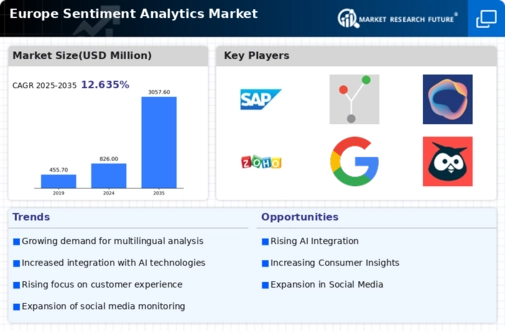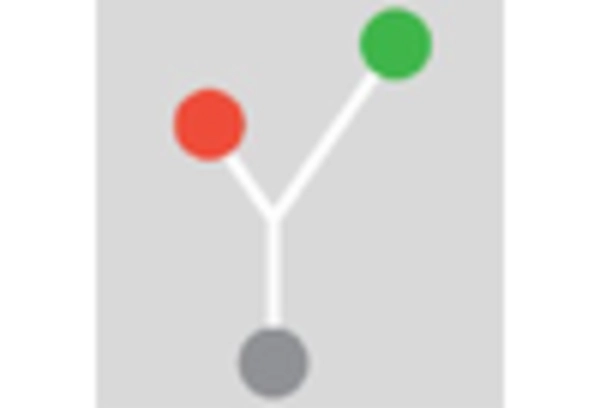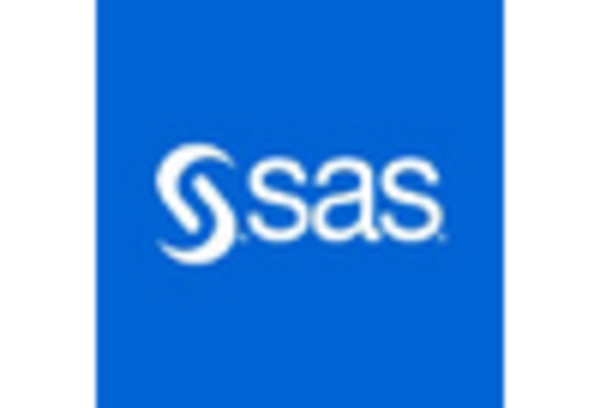Rising Demand for Customer Insights
The sentiment analytics market in Europe is experiencing a surge in demand for customer insights. Businesses increasingly recognize the value of understanding consumer emotions and opinions to enhance their products and services. This trend is driven by the need for personalized marketing strategies, which can lead to improved customer satisfaction and loyalty. According to recent estimates, the market is projected to grow at a CAGR of approximately 20% over the next five years. Companies are investing in sentiment analysis tools to gain a competitive edge, as they seek to interpret vast amounts of data from social media, reviews, and surveys. This growing emphasis on customer-centric approaches is likely to propel the sentiment analytics market forward, as organizations strive to align their offerings with consumer expectations.
Emergence of Real-Time Analytics Solutions
The emergence of real-time analytics solutions is transforming the sentiment analytics market in Europe. Businesses are increasingly seeking the ability to analyze consumer sentiments as they occur, rather than relying on historical data. This shift is driven by the need for timely insights that can inform immediate decision-making and marketing strategies. Real-time sentiment analysis enables organizations to respond swiftly to customer feedback, enhancing their agility in a fast-paced market. The demand for such solutions is projected to grow, with estimates suggesting that real-time analytics could capture over 30% of the sentiment analytics market by 2027. This trend highlights the importance of immediacy in understanding consumer sentiments and adapting business strategies accordingly.
Advancements in Natural Language Processing
Advancements in Natural Language Processing (NLP) technologies significantly influence the sentiment analytics market in Europe. As NLP capabilities improve, businesses can analyze text data more accurately and efficiently, leading to better insights into customer sentiments. Enhanced algorithms allow for the interpretation of nuances in language, such as sarcasm and context, which are crucial for accurate sentiment analysis. The European market is witnessing a shift towards more sophisticated sentiment analysis tools that leverage these advancements. This trend is expected to drive market growth, with estimates suggesting that the NLP segment could account for over 40% of the overall sentiment analytics market by 2026. As organizations increasingly adopt these technologies, the demand for skilled professionals in NLP is also likely to rise, further fueling the market.
Increased Focus on Brand Reputation Management
In Europe, the sentiment analytics market is significantly impacted by the heightened focus on brand reputation management. Companies are increasingly aware of the potential risks associated with negative public perception and are utilizing sentiment analysis to monitor and manage their online presence. By analyzing customer feedback and social media interactions, businesses can proactively address issues and enhance their brand image. This proactive approach is crucial in a competitive landscape where consumer opinions can rapidly influence purchasing decisions. The market for sentiment analytics tools aimed at reputation management is projected to grow, with estimates indicating a potential increase of 25% in demand over the next few years. This trend underscores the importance of sentiment analytics in safeguarding brand reputation and fostering customer trust.
Regulatory Compliance and Data Privacy Concerns
The sentiment analytics market in Europe is increasingly shaped by regulatory compliance and data privacy concerns. With stringent regulations such as the General Data Protection Regulation (GDPR) in place, businesses must navigate complex legal frameworks when collecting and analyzing consumer data. This has led to a growing demand for sentiment analytics solutions that prioritize data privacy and ethical practices. Companies are seeking tools that not only provide insights but also ensure compliance with regulations, thereby mitigating potential legal risks. The market is likely to see a shift towards solutions that incorporate privacy-by-design principles, which could account for a significant portion of new investments in sentiment analytics technologies. As organizations adapt to these regulatory landscapes, the sentiment analytics market is expected to evolve accordingly.


















Leave a Comment